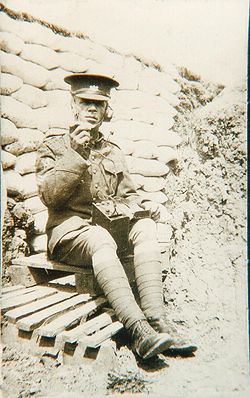Reading, Louis Philip
|
| Louis Philip Reading | |
|---|---|
| Died 4 January 1958 | |
 | |
| Nickname | Lou |
| Place of burial | Cataraqui Cemetery |
| Allegiance | Canada |
| Service/branch | Canadian Army |
Louis Philip Reading was a Canadian soldier and a member of the Royal Canadian Corps of Signals.
Blog[1]
On 23 June 1905 Louis Philip Reading enlisted in the King's Liverpool Regiment at Warrington, Lancashire, England. After two years service in the Aldershot Command he sailed for India and his first spell of Foreign Service. After serving at several outposts he trained as a regimental signaller at the Lahore Cantonment. In 1913 he returned to England, was discharged to the British Army Reserve, and shortly thereafter left for Canada.
When the First World War broke out, having left Toronto, Ontario for Ithica, New York, Lou proceeded (at his own expense) to Halifax, Nova Scotia to re-enlist. There, however, he was pronounced "no longer fit for war service". Undaunted he made his way to Toronto, apparently undergoing an improvement in health en route, and joined the Canadian Expeditionary Force as a "medically fit" sapper. When his signalling background became known he was made an instructor and served as such in Ontario at Barriefield, Petawawa and Ottawa. Coincidentally he became a Company Sergeant-Major (CSM).
Intent on going overseas Lou reverted to the rank of sapper, but was later reinstated as a CSM. In England he taught field cable and visual signalling at the Canadian Engineer Training Centre, Seaford, Sussex, and at the Signals Wing of the CSME. At the end of the war he was picked to be an instructor with the Siberian Expeditionary Force, but the influenza epidemic in England delayed his departure for Canada and he arrived too late to accompany the expedition to Vladivostock. On New Years' Eve, 1919, after a short tour at the Signal Training Depot, Ottawa, he was once more demobilized.
After six months with the Department of Soldier' Civil Re-Establishment Lou again re-enlisted and headed for the Instructional Staff at Military District 3, Kingston, Ontario. There, among other things, he taught elements of signalling to RMC cadets.
In 1924 he was posted to The Depot, RC Signals, at Camp Borden, Ontario, as a Quartermaster-Sergeant (QMS). When the Canadian Signal Training Centre opened at Vimy Barracks in 1937 he returned to Kingston as an instructor in field cable and general line work. When Regimental Sergeant-Major (RSM) T.J. Wallis was commissioned early in the Second World War, QMS Reading was appointed RSM. In March 1943, after a long tough fight against failing health, SM Reading was once again discharged.
In 1926, Lou Reading had been one of the first members of the Royal Canadian Corps of Signals to receive the Long Service and Good Conduct Medal and, subsequent to his release he had the rare honour of being awarded the British Meritorious Service Medal (MSM). His medals are on display at the Military Communications and Electronics Museum.
Lou Reading died on 4 January 1958 and was buried in Cataraqui Cemetery, Kingston, Ontario.
On 29 May 1998 the L.P. Reading Building, Vimy Barracks, Kingston, Ontario was named in his honour.
Related Items
References
.








